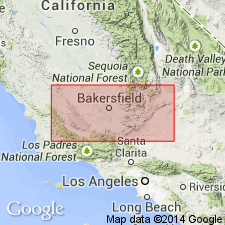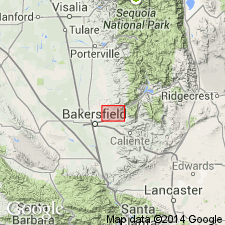
- Usage in publication:
-
- Pyramid Hill sand
- Modifications:
-
- Named
- Dominant lithology:
-
- Sandstone
- AAPG geologic province:
-
- San Joaquin basin
Summary:
Named for fossil bed in which ALLODELPHIS PRATTIS n. sp. was discovered. Type locality for holotype is SW/4 sec.12 T26S R28E, Woody 15' quad, Kern Co, CA. Composed of hard, white-to-brown sandstone 160 ft thick. At outcrop overlies 50 ft of mudstone reefs of "Walker" which in turn overlies basement complex. Age of beds debatably is Temblor or Vaqueros.
Source: GNU records (USGS DDS-6; Menlo GNULEX).

- Usage in publication:
-
- Pyramid Hill Sand Member*
- Modifications:
-
- Adopted
- AAPG geologic province:
-
- San Joaquin basin
Summary:
Pyramid Hill Sand of Wilson (1935) adopted as Pyramid Hill Sand Member of Jewett Sand. Type section designated as 185 ft subsurface cored interval from 1690 to 1875 ft in Shell Oil Jewett No.1 well (sec.29 T28S R29E in southern part of Round Mountain field, Kern Co, CA). Consists of gray to brownish-gray fossiliferous silty sand with local bentonitic and thin calcareous sandstone beds. Poorly sorted coarse-grained sand about 10 to 35 ft thick referred to as "grit-zone" occurs at base of unit. Overlies Vedder Sand. Is early Miocene age based on pelecypods of 'Vaqueros Stage".
Source: GNU records (USGS DDS-6; Menlo GNULEX).
For more information, please contact Nancy Stamm, Geologic Names Committee Secretary.
Asterisk (*) indicates published by U.S. Geological Survey authors.
"No current usage" (†) implies that a name has been abandoned or has fallen into disuse. Former usage and, if known, replacement name given in parentheses ( ).
Slash (/) indicates name conflicts with nomenclatural guidelines (CSN, 1933; ACSN, 1961, 1970; NACSN, 1983, 2005, 2021). May be explained within brackets ([ ]).

